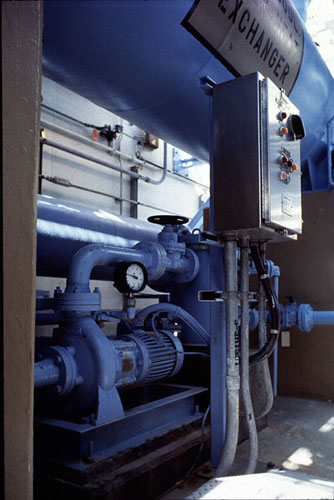
Pretreatment of cooling water systems is necessary to maximize the service life of heat exchange equipment. Usually, pretreatment consists of two phases:
Precleaning is important because it prepares the surface for the prefilming phase. After the surface has been cleaned, prefilming minimizes the initial corrosion which occurs at start-up and allows the most efficient application of a corrosion inhibitor program. Economics, discharge limitations, and time requirements dictate whether pretreatment should be applied to the entire system or to individual exchangers.
All new equipment should be precleaned for removal of grease, oil, corrosion products, mill scale, and dirt. Clean surfaces enable corrosion inhibitors to promote a uniform protective film. Failure to preclean can result in increased corrosion and fouling, leading to reduced heat transfer, excessive pressure drop across critical heat exchangers, premature failures, and high maintenance costs.
Precleaning should be conducted just prior to start-up, followed immediately by rapid passivation of surfaces (as outlined in the Prefilming section of this chapter).
Normally, a cleaning solution of polyphosphate, surfactant, and antifoam is circulated though the cooling system. Precleaning is essentially a detergent treatment. The polyphosphate and surfactant in hot water help remove light rust and hydrophobic materials left by manufacturing and construction. Polyphosphate is fed to achieve a concentration of 1-4% with the best results obtained at the higher dosages. The temperature is maintained at 120-160°F (50-70°C) and the pH is controlled in the range of 5.5-7.0. Higher water temperatures contribute to faster and more effective removal of unwanted materials.
Typically, cleaning is conducted over a period of 8-24 hr. When the program is completed, heavy blowdown is required for rapid removal of the precleaning chemicals.
Optimal results are attained when precleaning is performed at the recommended temperature elevations. Usually, it is difficult to achieve high temperatures unless individual exchangers are being treated with relatively small solution volumes. Lower solution temperatures can be compensated for by circulation of the precleaning solution for the maximal time period. Even at lower temperatures, precleaning significantly improves results.
Special precautions must be taken for new cooling towers built with wood that has been pretreated with a copper-based salt. The copper salts must be removed from the wood before any water is circulated through the system. Therefore, new towers should be thoroughly water-flushed and sumps should be drained and cleaned before precleaning takes place.
Most methods of corrosion control involve the formation of a film to act as a barrier to corrosion. The effectiveness of the treatment depends largely on the rate at which the barrier film is formed. Materials that do not allow rapid film formation permit corrosion to take place before a complete film layer has been created. Incomplete film formation contributes to continued corrosion. The rate at which the film forms is related to the concentration of the inhibitor.
Prefilming permits the rapid formation of a uniform film that immediately stifles the corrosion reaction. Once the film has been established, it can be maintained through continuous, low treatment levels to deter the accumulation of corrosion products.
Serious changes in environment (e.g., severe pH depression) can destroy the film, and corrosion products can accumulate before the film is reestablished through normal treatment. When this occurs, a prefilming program may be necessary for rapid repassivation of the system.
Prefilming of equipment in cooling water systems is recommended following initial installation, chemical cleaning, and start-up after turnaround or inspection. Prefilming may also be necessitated by low pH excursions or process leaks. This depends on the severity of the condition and the length of time the cooling equipment has been exposed to severe conditions.
Phosphate and zinc are used in prefilming programs. For prefilming of copper alloys, azoles are also used.
Polyphosphates are most important because they effectively remove undesirable corrosion products as they form, while developing a protective oxide film. Generally, these materials are circulated through the system at concentration ranges of 300-600 ppm phosphate and 30-60 ppm zinc.
A prefilming program using phosphate and zinc can be effective in rapidly providing a protective film. This program is maintained for 4-6 hr at a pH of 6.5-7 and a temperature of 120°F. The system is then heavily blown down until the phosphate level drops below 20 ppm. If a high pH program is to be applied, the phosphate level must first be further reduced to less than 3 ppm. The pH should then be adjusted until it reaches the level of the continuous program.
As previously stated, azoles are used for the pretreatment of exchangers fabricated with copper alloy tube bundles. Typically, pretreatment is applied to individual exchangers rather than an entire system. This is especially true for cooling systems using brackish water, where it is difficult to establish or maintain effective copper corrosion protection. Under these conditions, the individual exchangers are pretreated with fresh water and a copper corrosion inhibitor. The treated water can be circulated through the exchanger for a short period of time at ambient conditions to establish a uniform protective film. After prefilming is complete and the exchanger is back in service, continuous or periodic shot feed treatment applications serve to maintain film integrity.
Another method of prefilming is an increase in inhibitor levels for 6-24 hr. Although this is somewhat easier, it is less efficient and is generally used only when the continuous inhibitor program is phosphate-based.
Other considerations and precautions involved in precleaning and pretreatment are summarized below:
Pretreatment is critical for cooling water systems containing steel because of the higher corrosion rates that occur. Systems containing other metals, such as Admiralty Brass or copper alloys, can also benefit from pretreatment.
In general, pretreatment, followed by ongoing treatment programs, minimizes corrosion for improved heat transfer, longer service life, and reduced plant maintenance.

